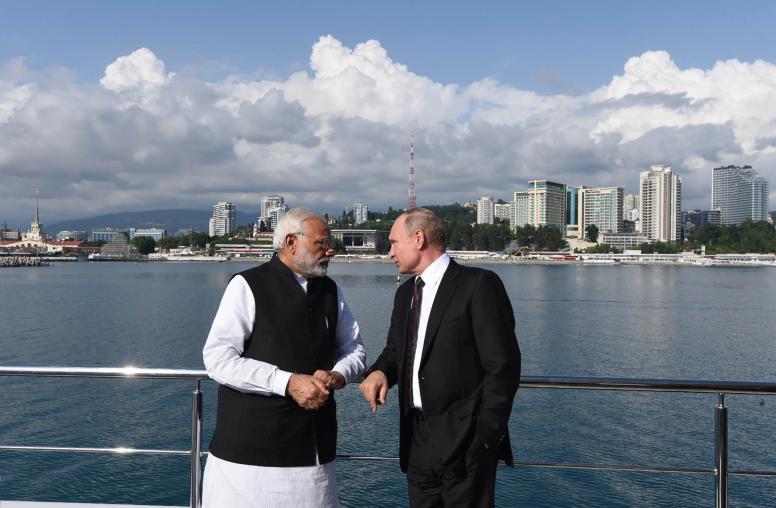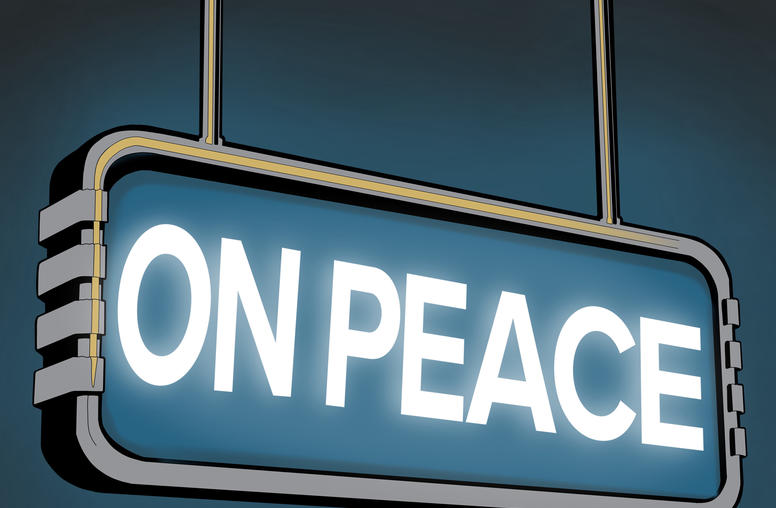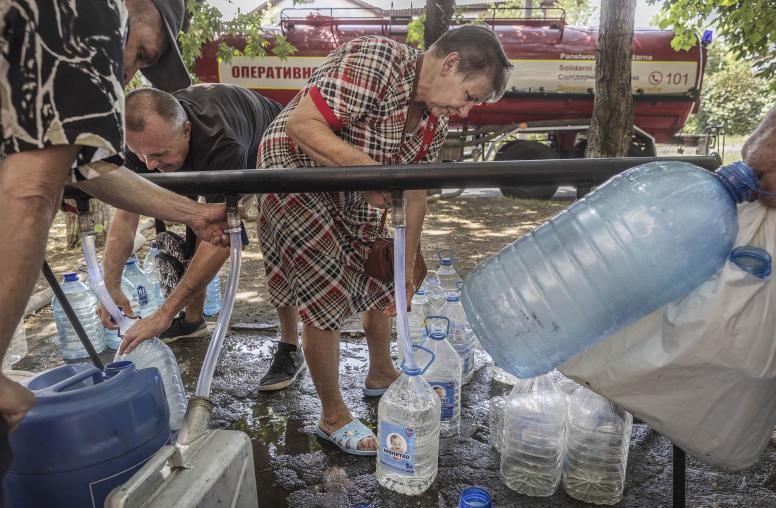How to Beat a Russian Occupation with Flash Mobs
Why nonviolent resistance might be the best hope for thwarting Putin's adventurism in eastern Ukraine.
As separatists in eastern Ukraine stage demonstrations and occupy government buildings, calling for Russian annexation, there is renewed anxiety about the 40,000 Russian troops massed along the border. The prospect of Russian incursion raises the question of how Ukrainians -- outnumbered, outgunned, and more than likely unsupported by Western militaries -- might be able to resist. Though there have been murmurs of Moscow's troops being met with a guerilla campaign, Ukrainians best hope for challenging Russian aggression might be to follow the same method used to oust Kiev's venally corrupt regime: civil resistance.

When Russian forces swarmed into Ukraine's Crimean peninsula for what became a military occupation and then an annexation, some opponents responded in ways that might seem unusual. In cities across Ukraine, flash mobs mimicked "dead bodies" on supermarket floors. Compatriots next to them held signs exhorting shoppers not to buy Russian products so as not to finance occupation and war. In Odessa, a flash-mob orchestra played "Ode to Joy," the European anthem, to the surprised onlookers at the city market in a melodic message supporting an alliance with the European Union rather than Russia. The videos went viral.
It may seem counterintuitive that such nonviolent resistance could successfully repel a militarily superior opponent, or that this would be Ukraine's most promising defense against having its east carved up by Russia. But evidence shows that nonviolent resistance is roughly twice as effective as armed struggle in ousting dictators and ending foreign occupations. A 2011 study [co-written by one of the authors, Maria Stephan] examined 323 violent and nonviolent campaigns from 1900 to 2006 and found that the nonviolent campaigns succeeded 53 percent of the time, compared to 27 percent for armed struggles, even against similarly repressive opponents.
The case for civil resistance, then, is a practical one: Not only has it been proven more effective at ousting occupying armies, it is much more likely than its violent counterpart to help consolidate democracy and peace. What's more, it does so at far lower cost than even "successful" armed resistance. Coalition building, persuasion, and negotiation, abilities that are vital for successful political engagement once transition begins, are all critically honed during civil resistance campaigns.
Today, the marches, silent demonstrations, and public appeals for unity among both Ukrainian and Russian citizens that comprised the months-long mass civil disobedience that forced Viktor Yanukovych from power in late February could, and probably should, form the basis of a national strategy to resist Russian occupation and military aggression. In Crimea, hundreds of Ukrainian soldiers marched without weapons toward Russian military contingents, blocking their base near Sevastopol and successfully forced the Russian commanders to negotiate. Though the base remained blocked, the Ukrainian soldiers and their commander became national heroes and built international sympathy for their struggle. As a result of the economic boycotts in Ukraine, some unconfirmed reports by activists say that the consumption of Russian products in the country dropped 40 percent within the first two weeks after the invasion of Crimea. Acts of resistance like this can be replicated, coordinated, and expanded into a nationwide movement that consistently raises the social, political, and economic costs of Russian presence in Ukraine, until occupation finally becomes untenable.
* * *
Calls for Ukrainians to take up arms are growing louder both internally and from the outside. On March 18, the acting president decreed a partial mobilization of the Ukrainian armed forces, and called up reservists. The Ukrainian National Guard was also reestablished. National defense units are undergoing combat training and developing their own videos warning Russians that further invasions will be met with arms. Young Ukrainians have been circulating a Swiss Army manual that explains how to wage guerrilla warfare. Members of the small extremist Crimean Tatar fringe, now fighting with anti-government rebels in Syria, have announced that they are contemplating a return to Crimea to fight the Russians. Dangerously, some Western pundits are suggesting that the West would be more willing to help when Ukrainians showed the world their willingness to fight with weapons.
The cavalry isn't going to come, though. The United States and other NATO member nations have made it clear that a Western military response against Russia isn't likely, meaning it will largely be up to Ukrainians to defend themselves. Before taking up arms, the Ukrainians would do well to consider how to accomplish this without resorting to guerilla warfare would likely lead to massive casualties.
There are a few different ways options for civilian defense: Ukrainian civilians could completely withhold social, political, economic, and security cooperation with Russian forces in the event of an expanded occupation. The Czechs and Slovaks adopted a similar strategy after Soviet troops invaded then-Czechoslovakia in 1968, and activists even developed "Ten Commandments," in case a Soviet soldier approached: Don't know, don't care, don't tell, don't have, don't know how to, don't give, can't do, don't sell, don't show, and do nothing.
Civil resistance saved hundreds of thousands of lives, while paving the way for Czechs and Slovaks to shake off communism and build democracy. Admittedly, that struggle took years. But armed resistance has historically delivered neither faster nor better results -- research shows that the average civil resistance campaign takes two and a half years, compared to nine years for armed resistance. The relatively quick ouster of Yanukovych, furthermore, suggests that a well-organized, disciplined civil resistance campaign does not necessarily require years to succeed.
A Ukrainian civil defense strategy could be coupled with a campaign for solidarity with ethnic Russians living in Ukraine. Independent, Russian-language media could be beamed into Crimea and to southern and eastern Ukraine, with popular Ukrainians, Russians, and international celebrities using humor, music, and messages emphasizing Ukraine for all Ukrainians. They could also broadcast instructions for engaging in mass nonviolent disruption to thwart further Russian military incursions.
A Russian occupation of Ukraine would require hundreds of thousands of troops and thousands more logistics personnel who would be dependent, at least in part, on local cooperation to run the country and keep the lights on. If Ukrainian civil servants walked off their jobs, and if key industries slowed or stopped, the ongoing, frustrating burden could sap the Russian will for adventurism without the incitement of snipers and bombings, which would almost invariably lead to divisive crackdowns and reciprocal violence. Ukrainian society could start building solidarity and mutual-aid funds now to support would-be strikers.
As for external support, international allies -- governmental and non-governmental -- should increase their assistance to nonviolent Ukrainian activists in the form of small grants, technical advice, and media assistance. This is an effort that non-governmental organizations and foundations less encumbered by bureaucratic inertia should lead. Specialized peace organizations could work with their Ukrainian and Russian counterparts to interject nonviolent "peace brigades" into volatile regions of Ukraine to help maintain nonviolent posture between unarmed people and violent actors, offer protective accompaniment, and gather evidences of rights violations in case of invasion. Communication should be intensified between Ukrainian activists and those from other countries -- from Central and Eastern Europe and beyond -- who have resisted similarly repressive opponents nonviolently.
Ukrainians will ultimately be the ones to decide whether and how to fight if Russia invades their country. But the international community should not wait for the crisis to escalate before providing support to the many Ukrainians who remain committed to nonviolent resistance. Their strategy stands the best chance to pull Ukraine back from the brink.
 This story was originally published on FP's Peace Channel, a collaboration between Foreign Policy and the U.S. Institute of Peace.
This story was originally published on FP's Peace Channel, a collaboration between Foreign Policy and the U.S. Institute of Peace.



